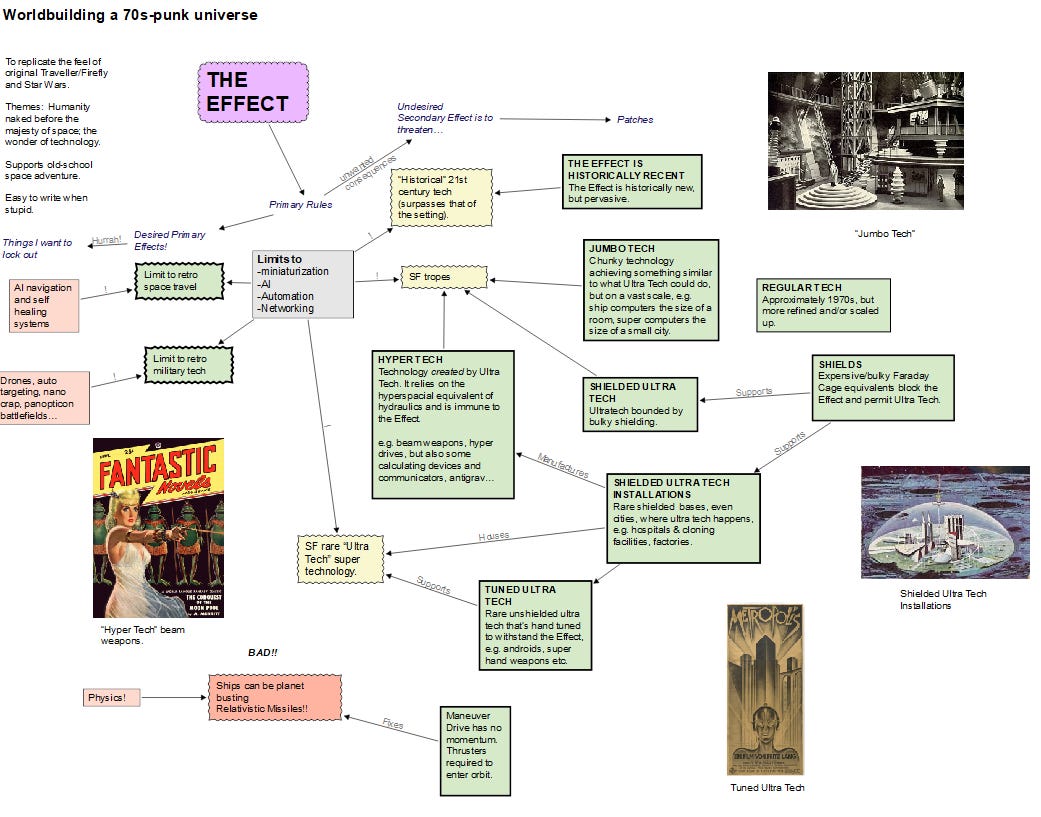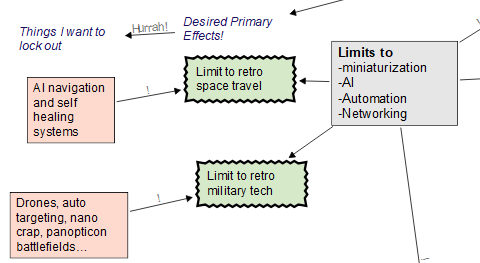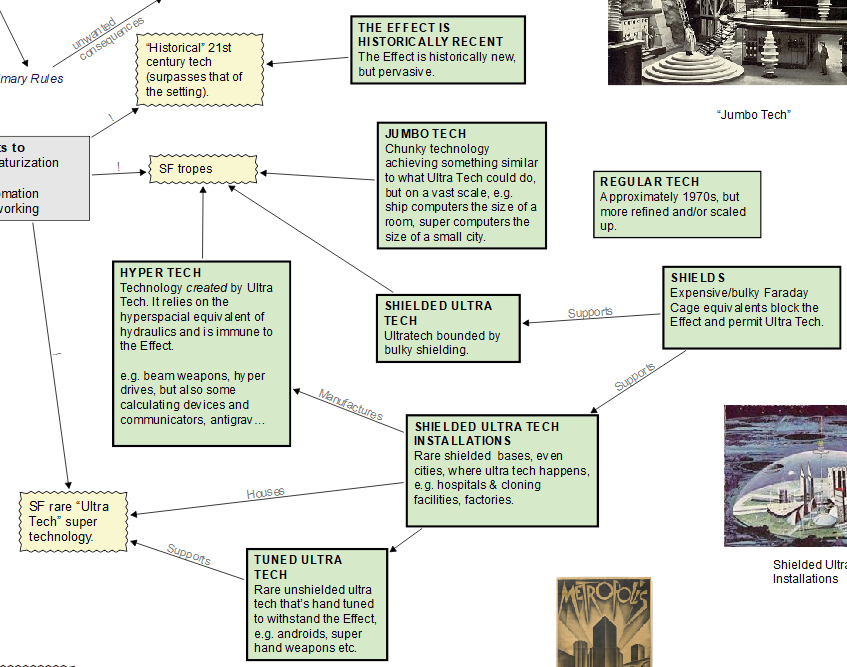70s SciFi Worldbuilding (1): Nerfing the tech in a way that makes sense
Using Conflict Diagrams to fine-tune a Transistor Punk Space Opera setting
I like my story worlds not to break when you think about them too much.
It’s a quirk that’s probably held me back, but I can’t just invoke the Rule of Cool and move on. That’s why I haven’t done much Science Fiction; too much extrapolation.
…and by the way, if we’re doing extrapolation, look up what’s going on with polygenetic testing and try to work out what the future is really going to look like when that gets into the wild…
Except right now, I don’t want to do extrapolation. I don’t want to tell stories in a world where a gene swab reveals your personality, where armed conflict is swarms of nanobots stunning the opposition, where everything is automated, and surveillance is the default.
I do want to tell old-school Space Adventures set in the vastness of space, where humans are naked before stars, where really powerful technology is magical and awesome.
And I don’t want to have to think too much about the setting. This is the writing equivalent of the comfort read.
Like this: (No paywall, btw, more thoughts beyond the draft cover.)
So what can put a damper on technology?
There are basically three ways to limit technology in an SF setting:
Society can have rules keeping it back. This worked fine for The Dread Empire’s Fall series by Walter Jon Williams (all Amazon links are affiliate, btw), where the mad alien masters limited the tech available to humans.
Society can have forgotten how to make the technology, as per Herbert’s Dune and parts of Asimov’s Foundation series. That seems to be also semi-true for Star Wars.
Alas, these solutions don’t scale.
A galaxy-sweeping saga is going go beyond the bounds of such walled gardens, and alien races aren’t going to play nice.
There is also the issue that — realistically — the inhabitants, especially the kind of super scientist beloved of old SF, would keep trying to break the setting.
That leaves:
An Effect that conveniently gates the tech you don’t want. SM Stirling based the entire Dies the Fire series on such authorial fiat (though the story is earthbound). Vernor Vinge’s Fire upon the Deep, proper over-the-top space opera, has Zones of Thought, so that different parts of the galaxy can support different levels of intelligence — don’t drift into the moron zone…
Obviously, it’s Option 3 I’m going for.
Option 3 - the technology doesn’t work for reasons
I’m going to shamelessly work back from the effects I want/don’t want.
That’s this part of my diagram:
Basically, let’s not have AI navigation, selfhealing systems, drones, auto targeting, nano… stuff, panopticon battlefields…
It’s all cool to write about, but not what I’m after right now.
This means limiting the miniaturisation, AI, automation, networking. Unfortunately, that potentially breaks a lot of Space Opera tropes, and also raises awkward questions about why the setting’s tech is worse than that of the reader:
I have fixes for this:
First, there’s the Shield. It’s like a Faraday cage, but bulkier with more coils and sparks and flashing lights, and it protects the inside from the Effect (whatever that is). And it’s expensive.
Once you can have a Shield, you can operate near magic “ultra tech”, and maybe manufacture other technology that itself is immune to the Effect… in this case Shielded Ultra Tech, Tuned Ultra Tech, and Hyper Tech.
Then there’s scale, which is very retro tropey. Want a super computer? Fine. First purchase your football field.
That leaves the knotty problem that the PC I’m typing this on is better than anything my characters are going to have.
It follows that the Effect is historically recent. Sometime in the late 21st century, the really powerful microelectronics stopped working and the Internet died.
I’m thinking some kind of Vingian galactic pulse that goes in cycles…
The rewards of worldbuilding
Oh look, I’ve created a generic 70s SciFi setting, but one that’s more than skin deep… one that generates plot.
For example, space archaeology and tomb world raiding now have a point. Maybe you can find some old “tuned ultra tech” that would be really expensive to reproduce. Or maybe you can find a well-preserved factory belonging to a crashed alien civilisation, construct a shield over it, and get it going again?
There are also shielded cities with ultra tech facilities that can regrow your arm or clone your dead wife, or where you can by a super expensive knife missile.
Mad scientists can do mad science, but they can’t break the setting.
You could run the original Traveller TTRPG in this setting and it would make sense. So would Star Wars.
But, what what is the Effect?
I’m not sure yet. I suspect it’s something to do with information density, so more qualitive than quantitative.
We’ll see…
If you like the diagramming system, you’ll find an explanation of it in my old book Storyteller Tools…










I like your thinking. I never thought of working backwards from what I don't want, but trying to eliminate unwanted tech to support the story is often a problem for me. When I read how you approached it, my brain jumped right to some kind of tech nanovirus (low hanging fruit?). BTW, your book Storyteller Tools was one of the best I've ever read on story structure. I've never published, but I've spent hundreds of enjoyable hours planning and writing story drafts using your techniques. Good to see you on Substack. I hope this works out well for you!